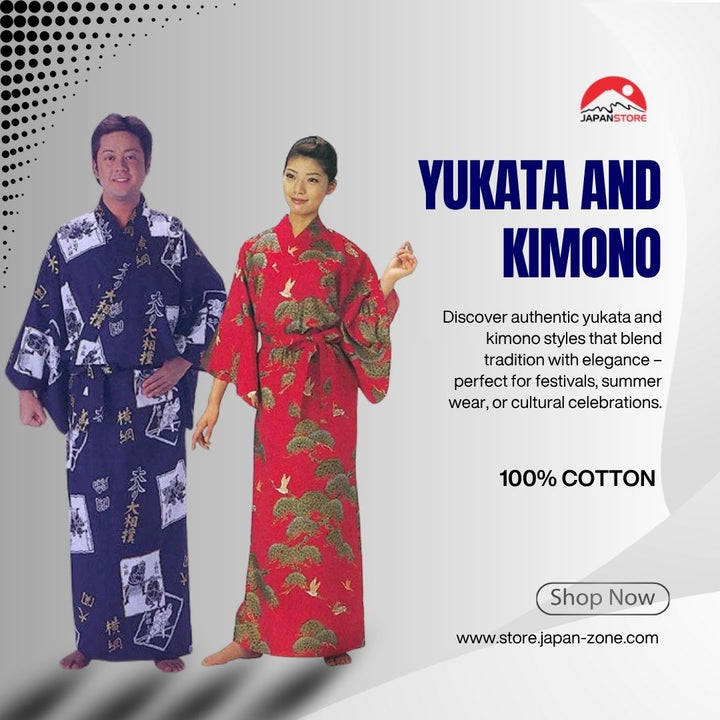At Japan Store, we know that many of our customers love exploring traditional Japanese fashion—especially when it comes to garments like the yukata and kimono or those special Japanese summer kimono pieces. Yet despite their shared heritage, these garments have distinct features, occasions and styling rules. In this blog post we’ll explore those differences in detail, help you decide when to wear each, and guide you in choosing the right piece for the right moment.
Understanding the Terms: Yukata and Kimono!
Before we dig into differences, let’s clarify what we’re talking about when we say yukata and kimono, including the phrase Japanese summer kimono.
- A kimono is a broad term for a traditional Japanese robe-style garment, typically made to cover the body, with overlapping front panels, long sleeves, and an obi (belt).
- A yukata is a lighter, more casual version of that robe, typically made of cotton or other breathable fabric, often worn in warmer weather or at informal settings.
- When we talk about a Japanese summer kimono, we are often referring to kimono styles tailored for hotter months (unlined, lightweight fabric) or the yukata itself, which is essentially a summer version of the kimono.
Now, with those definitions in place, let’s dive into the key differences.
Key Differences Between Yukata and Kimono
Fabric, Structure & Seasonality
- Yukata are commonly made of cotton or linen, unlined, and intended for warmer weather or casual settings.
- Kimono are often made from silk, wool, synthetic blends or other higher-end fabrics, may be lined or unlined depending on the season, and are worn year-round including formal occasions.
- Because of that, yukata are sometimes referred to as a “casual summer kimono.”
Formality & Occasions
- A kimono can be formal or semi-formal depending on the type, fabric, pattern, accessories. It is often worn to weddings, formal tea ceremonies, graduations, or special events.
- A yukata is more relaxed. It is typical for summer festivals, fireworks events, casual outings, or even loungewear in a traditional inn (ryokan) settings.
Sleeves, Layers & Undergarments
- Kimono often require multiple layers: an under-garment called a “nagajuban”, then the kimono itself, plus accessories.
- Yukata typically have fewer layers; often a single piece, no heavy lining, and minimal or no under-garments beneath (especially for casual wear).
- Sleeve length may differ: women’s kimono have longer sleeves in some formal types; yukata sleeves are shorter and simpler.
Patterns & Colours
- Yukata patterns tend to be bold, bright, seasonal (floral, fireworks, summer motifs) because they’re designed for festivals/outdoor summer use.
- Kimono patterns may be more subdued or symbolic, especially in formal versions. They can reflect season, age, occasion.
Footwear & Accessories
- With kimono you will often see tabi socks and zori sandals.
- With yukata, more casual footwear often applies: geta sandals, simpler obi (belt), fewer accessories.
How to Choose Between Yukata And Kimono?
When you’re shopping at Japan Store for your yukata and kimono or a proper Japanese summer kimono, here are practical guidelines to help you choose.
1. Consider the Occasion
- If you’re heading to a formal event (wedding, formal dinner, tea ceremony): lean towards a kimono.
- If you’re attending a summer festival, fireworks, informal gathering, or simply want a relaxed traditional look: a yukata works wonderfully.
- If you need a Japanese summer kimono (lightweight, unlined kimono for summer): look for kimono labelled as “summer kimono” or “unlined” versions in cotton/sheer fabric.
2. Consider Fabric & Comfort
- For hot weather: go for a yukata or summer-kimono: cotton/linen, unlined, breathable.
- For cooler evenings or more formal dressing: choose a kimono with suitable fabric and lining.
- At Japan Store look for product listings: cotton “yukata” collections, or kimono with summer-label tags.
3. Consider Your Experience & Styling
- If you’re new to traditional garments and want something easier to wear: a yukata is simpler to put on and style.
- If you want full traditional styling and are willing to deal with more accessories (obi, under-layers, tabi, zori): a kimono will be more involved but more traditional.
- For “Japanese summer kimono” buyers: choose a kimono with lighter build, smaller accessories.
4. Accessory Match
- With yukata: simpler accessories fit—e.g., a basic obi, geta sandals, minimal jewellery.
- With kimono: you’ll need a full set of accessories: obi, obi-jime, obi-age, tabi socks, zori sandals, possibly haori jacket.
- Make sure the footwear, hairstyle and handbag complement the level of formality.
5. Budget & Maintenance
- Yukata are typically more affordable (lighter fabric, less lining, simpler styling).
- Kimono, especially formal silk ones, can be expensive and require careful maintenance (dry cleaning, storage).
- If you plan occasional wear for summer outings, a yukata or summer kimono from Japan Store offers great value.
Styling Tips and Care for Your Yukata, Kimono or Japanese Summer Kimono
Styling Tips
- For a yukata look: choose a vibrant pattern, tie the obi in a simple bow at the back, pair with geta sandals, and keep jewellery minimal for a summer-festival aesthetic.
-
For a Japanese summer kimono (unlined): pick lighter colours, use the same obi-belt but maybe lighter material, and pair with zori sandals rather than heavy footwear.
-
For a full kimono look: choose your jewellery and accessories appropriately—ensure the obi knot is neat, the collar sits correctly, and your footwear (zori) and socks (tabi) match the formal level.
- Colour coordination: match the garment with season and your age/mood: younger wearers may select brighter prints in yukata, mature wearers may choose more subdued prints.
Care & Storage
-
Yukata: since fabric is cotton and unlined, you can often hand-wash or gentle machine wash; avoid strong detergents, hang to dry in shade.
-
Kimono: especially silk or lined versions require professional cleaning, careful folding (tatou), stored in a cool, dry place, away from direct sunlight.
-
For both: avoid folding along decorations/patterns repeatedly; air periodically to prevent mould; keep accessories separated.
- At Japan Store we recommend you check the care instructions on each listing to preserve your garment’s quality.
Why Japan Store is Your Go-To Place?
At Japan Store, we specialise in authentic, well-crafted yukata and kimono, including summer varieties like Japanese summer kimono. What sets us apart:
- We carry a wide range of fabrics, from basic cotton yukata to more refined summer-kimono and full-formal kimono.
- We provide clear sizing charts, fabric descriptions, and styling tips so you can pick confidently.
- We help you understand the accessories required (obi, sandals, etc.) so your purchase becomes a complete look, not just a garment.
- For global customers, we provide secure shipping, size conversion info, and customer support to ensure your traditional wear arrives ready to wear.
Frequently Asked Questions (FAQs)
Q1: Can a yukata be worn in the same way as a kimono?
A: While both garments share the same basic robe structure, in practice a yukata is designed for casual, warm-weather wear without the layers and formality of a kimono. So yes you can wear a yukata like a kimono, but you’ll likely look more relaxed and less formal.
Q2: What exactly is a “Japanese summer kimono”?
A: A Japanese summer kimono refers to a kimono style specifically made for hot weather—unlined or lightly lined, breathable fabric (e.g., cotton, linen), lighter weave, and worn in summer months. It bridges between yukata and formal kimono.
Q3: Are the accessories the same for yukata and kimono?
A: No—accessory complexity differs. A kimono often requires obi tie variations, tabi socks, more formal sandals (zori) and other pieces. A yukata uses fewer accessories—lighter obi, often no under-garment layer, and geta sandals for casual settings.
Q4: Can men wear yukata and kimono too?
A: Absolutely. Both yukata and kimono are worn by men and women, though the patterns, colours, and some styling rules differ (men’s versions are typically simpler in pattern and colour).
Q5: Which should I buy if I only plan to wear traditional wear once a year, say at a summer festival?
A: For a one-time summer festival event, a yukata is likely the best choice: more affordable, easier to style, lighter fabric, appropriate for summer. However, if you anticipate multiple uses or want a more elevated look, you could consider a summer kimono from Japan Store.
Conclusion
In the world of traditional Japanese clothing, knowing the difference between yukata and kimono—and understanding when and how to wear a Japanese summer kimono—allows you to choose with confidence, style and appropriateness. At Japan Store, we offer you a curated selection of both types, along with expert guidance to pick the right one for your occasion, season and budget.
Whether you go for the relaxed ease of a yukata, the seasonal lightness of a summer kimono, or the refined elegance of a full kimono, you’ll be connecting with centuries of tradition and craftsmanship. And when you choose well, you’ll enjoy the comfort, the look, and the authenticity of your garment.
Explore our collection today, and step into the world of Japanese traditional wear with knowledge and style!





